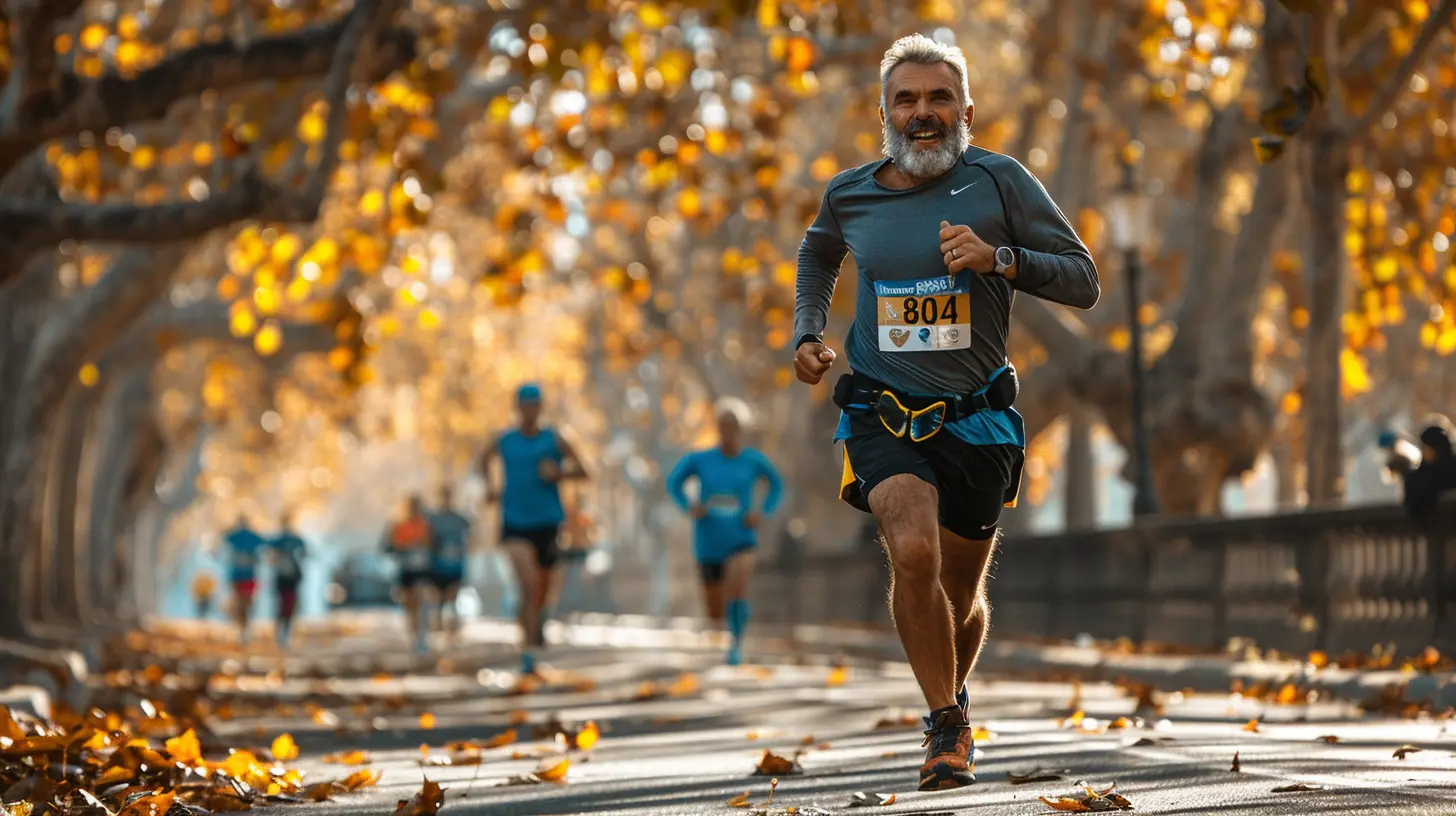Marathon Running for Seniors: Staying Fit and Injury-Free
5 November 2025
Running a marathon is no small feat. It demands discipline, determination, and a whole lot of heart—regardless of your age. But for seniors, stepping into the marathon world can be a game-changer. Not just for fitness, but for life itself. Whether you’re 60 or 75, lacing up your sneakers and pounding the pavement can give you a renewed sense of purpose.
Yet, let’s be real. Running long distances later in life comes with its own set of challenges. Achy joints, slower recovery, and stiffer muscles? Yep, those are part of the deal. But here’s the good news—those hurdles aren’t stop signs. With the right mindset, training approach, and care, marathon running can be a safe, rewarding, and downright exhilarating journey.
In this guide, we'll walk (or jog!) through everything you need to know about marathon running for seniors—how to stay fit, avoid injury, and cross that finish line with a smile. Ready? Let’s hit the ground running.
Why Marathon Running Is a Great Choice for Seniors
Let’s start here: Why even consider running a marathon after 60?Because it's not just about running. It's about living.
Boosts Physical Health
Sure, running strengthens your heart and burns calories. But for seniors, it does even more. It helps maintain bone density, keeps blood pressure in check, and improves mobility. Kind of like hitting the reset button on aging.Builds Mental Resilience
Running tests more than legs—it tests character. Training for a marathon builds mental toughness, focus, and emotional balance. It’s meditative. It clears the mental cobwebs and helps you feel more in control of your mind and body.Creates a Sense of Community
Running isn't a lonely sport unless you want it to be. Marathon training groups, local running clubs, and race day crowds offer rich opportunities to build friendships and find encouragement. It’s like joining a tribe that cheers for every step you take.A Goal Worth Chasing
Finishing a marathon at any age is a badge of honor. For seniors, it’s a symbol of vitality. It gives you something to aim for, a reason to lace up your shoes even when your bed is tempting you to stay tucked in.
Not All Miles Are Created Equal: Senior-Specific Concerns
Okay, so running has its perks. But let’s address the elephant in the room—getting older changes things. And that’s totally okay. You’re wiser now, and hopefully more patient too. The secret to success lies in adjusting your approach, not giving up on the dream.Slower Recovery Time
Your body doesn't bounce back like it used to. Your muscles need more time to heal, and that’s normal. You’re not fragile—you just need to respect your limits.Increased Injury Risk
The risk of joint pain, pulled muscles, and overuse injuries goes up. But with proper training and recovery, you can dodge most of these issues.Lower Muscle Mass and Bone Density
Aging leads to natural muscle loss and decreased bone strength. That’s why strength training and proper nutrition are so essential—you’re not just a runner, you’re a well-rounded athlete.
Creating the Perfect Training Plan (Yes, It’s Possible)
A cookie-cutter approach won’t cut it. Your training plan should fit like a glove and be flexible enough to adjust based on how your body feels.1. Start Slow, Build Smart
If you’re new to running, don’t go from couch to 26.2 miles in a month. Begin with walking or light jogging. Gradually add distance and intensity over weeks and months. Think of it like building a house—you need a strong foundation before adding the fancy stuff.2. Prioritize Rest Days
Rest is not a weakness. It’s part of the training. Seniors especially need recovery days to allow their bodies to repair, rebuild, and recharge. Listen to your body—if it's whispering "take a break," it's probably right.3. Strength Training Is Non-Negotiable
Running alone won’t cut it. Include strength workouts 2-3 times a week. Focus on core, hips, glutes, and leg muscles. These are your support crew—the stronger they are, the better you'll run.4. Flexibility and Mobility Work
Stretching and yoga aren't just for Instagram influencers. Flexibility work can help prevent injuries, improve balance, and increase stride length. Start and end every run with gentle stretching—your joints will thank you.5. Mix It Up with Cross-Training
Swimming, cycling, or using an elliptical machine can give your joints a break while keeping your cardiovascular system in top shape. It’s like giving your body a vacation while still keeping it productive.
Nutrition Tips for Senior Marathoners
You are what you eat, right? Well, when you're running 20+ miles a week, food becomes more than fuel—it becomes medicine.Stay Hydrated
Dehydration can sneak up on you, especially in older adults. Drink water throughout the day, and don’t wait until you're thirsty. On long runs, consider drinks with electrolytes.Eat Balanced Meals
You need carbs for energy, protein for muscle repair, and fats for long-lasting fuel. Think of your plate like a performance tool—not just a meal.Get Enough Calcium and Vitamin D
Bone health is everything for senior runners. Dairy products, leafy greens, and safe sunshine exposure can make a big difference.Injury Prevention: Run Smarter, Not Harder
Wouldn’t it be great if you could guarantee an injury-free training season? While that’s not always possible, there’s a lot you can do to lower the risk.Invest in Proper Footwear
Shoes are your most important tool. Get fitted at a running store, and replace your shoes every 300–500 miles. Old shoes are like bald tires—risky and uncomfortable.Warm Up and Cool Down
Always. No exceptions. Your warm-up gets the blood flowing and prepares your muscles. Cooling down helps transition your body to a resting state. Both are non-negotiable.Listen to Your Body
Pain is a signal, not a challenge. Don’t push through sharp aches or persistent soreness. When in doubt, take a break or consult a medical expert.Regular Check-Ups
Running long-term doesn't mean skipping doctor visits. Regular health screenings and physical check-ups ensure you’re running on all cylinders.Gear Up: What You Need (and Don’t Need)
Forget flashy gadgets—you don’t need a rocket-powered smartwatch to train for a marathon. But a few key items can make your journey smoother.- Comfortable Running Shoes – Fit is everything.
- Moisture-Wicking Clothing – Stay dry, avoid chafing.
- Running Belt or Vest – To carry water, snacks, and ID.
- Sun Protection – A hat and sunscreen are must-haves, especially since older skin is more sensitive.
The Mental Game: Running with Heart and Grit
Running a marathon isn't just physical—it’s deeply emotional. There will be days you feel unstoppable and days you want to quit. The key? Keep your "why" front and center.Set Micro-Goals
Breaking a marathon into bite-sized goals makes it less overwhelming. Focus on finishing your long run this week—worry about the race later.Embrace the Journey
Training is a rollercoaster of highs and lows. Appreciate every milestone—even the small ones. Every step counts.Visualize Race Day
Picture yourself crossing the finish line. Imagine the crowd, the medal, the moment. Visualization can be a powerful motivator.Race Day: What to Expect (And How to Crush It)
So, the big day is here. Butterflies in your stomach? Totally normal. Here’s how to make the most of race day.Don’t Try Anything New
Stick with your tried-and-true gear, meals, and warm-up routine. This isn’t the time for experiments.Pace Yourself
Start slow. The adrenaline may tempt you to go fast, but resist it. This is a marathon, not a sprint.Fuel Your Body
Bring energy gels, chews, or snacks that you’ve practiced with during training. Hydrate at every aid station.Soak It In
Enjoy the atmosphere. Smile at the spectators. High-five the volunteers. This is your moment—own it.Final Thoughts: You’re Never Too Old to Run
Let’s be clear—age isn’t a barrier. It’s a badge. Running a marathon in your 60s, 70s, or even 80s is an achievement worth celebrating. It shows grit, courage, and a refusal to let time dictate your story.So, if you’ve ever thought, "Maybe I’m too old for that," scratch that thought right now. Lace up, take the first step, and keep going. The finish line isn’t just a place; it’s a powerful reminder that you’re still in the race—and crushing it.
all images in this post were generated using AI tools
Category:
MarathonAuthor:

Uziel Franco
Discussion
rate this article
1 comments
Jet Dodson
Running marathons isn't just for the young—seniors can thrive too! Embrace the challenge, prioritize form, and listen to your body. Age is just a number; it's the determination and passion that define your journey. Stay fit, stay fierce, and conquer those miles!
November 6, 2025 at 3:34 AM

Uziel Franco
Absolutely! Age brings wisdom and resilience—seniors can definitely thrive in marathon running by focusing on form, listening to their bodies, and embracing the challenge. Keep moving and inspiring!


